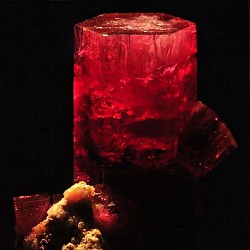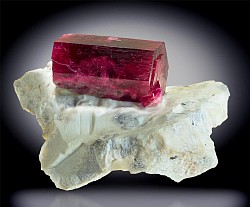Red Beryl:
The Scarlet Treasure of the Wah Wah Mountains
Unveiling the Rarest Gem on Earth
Red beryl, a gemstone so rare it eclipses even diamonds in scarcity, holds a captivating allure for mineral enthusiasts and collectors alike. Its vibrant crimson hue, born from a unique confluence of geological events, makes it a truly exceptional treasure. This comprehensive guide delves into the fascinating world of red beryl, exploring its origins, properties, and the thrill of seeking it out in its natural habitat.
Why is Red Beryl So Rare?
The rarity of red beryl stems from the extraordinary circumstances required for its formation. Imagine a geological recipe with highly specific ingredients and conditions:
* Beryllium: This element, essential for all beryl varieties, is itself quite scarce in the Earth's crust.
* Manganese: The trace element responsible for red beryl's distinctive color, must be present in sufficient quantities and at the right time during the mineral's crystallization.
* Unique Geochemical Environment: The ideal conditions involve beryllium-rich volcanic rhyolite lava flows, circulating groundwater, and the presence of manganese oxides. This combination is exceptionally rare, found only in a handful of locations worldwide.
These stringent requirements make red beryl a true geological anomaly, estimated to be 1,000 times rarer than gold. In fact, for every 150,000 diamonds unearthed, only a single red beryl crystal is found.
The Birthplace of Red Beryl
The Wah Wah Mountains of Utah, a rugged and remote landscape, hold the distinction of being the primary source of red beryl. Here, millions of years ago, volcanic activity created the perfect conditions for this rare gem to form. As the rhyolite lava cooled and fractured, beryllium-rich gases escaped, mingling with manganese-laden groundwater. This unique interplay of elements, within the cracks and cavities of the volcanic rock, gave rise to the stunning red beryl crystals we seek today.
Planning Your Red Beryl Expedition to the Wah Wah Mountains
Embarking on a red beryl hunting expedition in the Wah Wah Mountains is an adventure for the intrepid. This remote and challenging terrain demands careful preparation and a respect for the environment. Here's a comprehensive guide to ensure a safe and rewarding experience:
1. Essential Tools and Gear:
* Rock Hammer and Chisels: Opt for a geologist's hammer with a chisel end for breaking rocks and a flat end for prying. Cold chisels and a small sledgehammer can be useful for larger rocks.
* Hand Lens (10x Magnification): Essential for examining potential red beryl specimens up close.
* Shovel and Buckets: Helpful for moving dirt and debris while searching.
* Gloves and Eye Protection: Protect your hands from sharp rocks and your eyes from dust and debris.
* Sturdy Backpack: To carry your tools, water, snacks, and any red beryl finds.
* GPS and Maps: The Wah Wah Mountains are remote; reliable navigation is crucial. Download offline maps and mark potential digging areas.
* First-Aid Kit: Be prepared for minor injuries with a well-stocked first-aid kit.
* Sun Protection: The Utah sun can be intense. Wear sunscreen, a hat, and sunglasses.
* Plenty of Water: Hydration is vital, especially in the desert environment. Carry more water than you think you'll need.
2. Safety First:
* Weather Awareness: Check the forecast before you go and be prepared for sudden changes. Flash floods can occur in canyons.
* Wildlife Awareness: Be mindful of rattlesnakes, scorpions, and other desert creatures. Wear sturdy boots and avoid reaching into crevices.
* Communication: Let someone know your plans and expected return time. Cell service can be spotty, consider a satellite phone or personal locator beacon for emergencies.
* Mining Regulations: Familiarize yourself with any local mining regulations and claim boundaries. Obtain any necessary permits before you start digging.
* Physical Fitness: Hiking and digging in the Wah Wah Mountains can be physically demanding. Be in good shape and know your limits.
3. Tips and Tricks for the Advanced Red Beryl Hunter:
* Geological Knowledge: Understanding the geological formations and the specific conditions where red beryl forms can significantly increase your chances of success. Research the area and look for signs of volcanic rhyolite and potential cavities.
* Focus on Existing Dig Sites: While discovering a new red beryl location is the ultimate dream, focusing your efforts on known or previously worked areas can be more productive.
* Look for Associated Minerals: Red beryl often occurs alongside other minerals like topaz, quartz, and hematite. Finding these can be a good indicator that you're in the right area.
* Patience and Persistence: Finding red beryl takes time and dedication. Don't get discouraged if you don't find anything right away. Keep searching and exploring!
* Respect the Environment: Practice Leave No Trace principles. Pack out everything you pack in and minimize your impact on the landscape.
4. What to Expect When Searching for Red Beryl:
* Challenging Terrain: The Wah Wah Mountains are rugged and remote. Be prepared for steep slopes, loose rocks, and limited access.
* Variable Weather: Conditions can change rapidly, from scorching heat to sudden thunderstorms. Be prepared for anything.
* Limited Amenities: There are no facilities or services in the immediate area. Come fully self-sufficient.
* The Thrill of Discovery: Despite the challenges, finding a red beryl crystal is an immensely rewarding experience. The thrill of unearthing this rare gem is a feeling like no other.
5. Responsible Collecting:
* Minimize Disturbance: When digging, try to minimize your impact on the environment. Fill in any holes you create and avoid disturbing vegetation.
* Specimen Preservation: Handle red beryl crystals with care to avoid damage. Wrap them securely for transport.
* Ethical Considerations: Consider the ethical implications of collecting red beryl. Some may argue that these rare gems should be left in their natural environment.
6. HiddenGemEDU.COM Resources:
* Advanced Guides and Maps: Access detailed geological maps, GPS coordinates of known red beryl locations, and advanced tips from experienced collectors.
* Expert Consultation: Seek advice from our team of geologists and gem experts.
7. Beyond the Search:
* Gem Cutting and Faceting: Learn about the intricate process of transforming raw red beryl crystals into stunning gemstones.
* Jewelry Design: Explore the creative possibilities of incorporating red beryl into unique jewelry pieces.
* Gemological Education: Deepen your understanding of gemology and the science behind red beryl's rarity and beauty.
Conclusion:
The pursuit of red beryl in the Wah Wah Mountains is an adventure that combines geological knowledge, physical endurance, and a passion for rare treasures. While the journey may be challenging, the reward of discovering this scarlet gem is an experience that will stay with you forever. By preparing carefully, respecting the environment, and utilizing the resources available at HiddenGemEDU.COM, you can embark on a red beryl expedition that is both safe and fulfilling.




